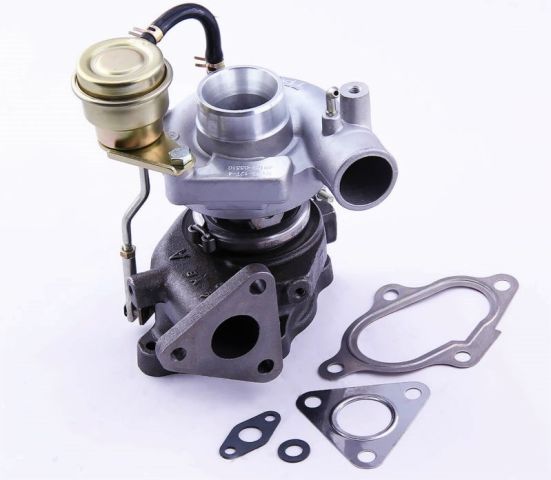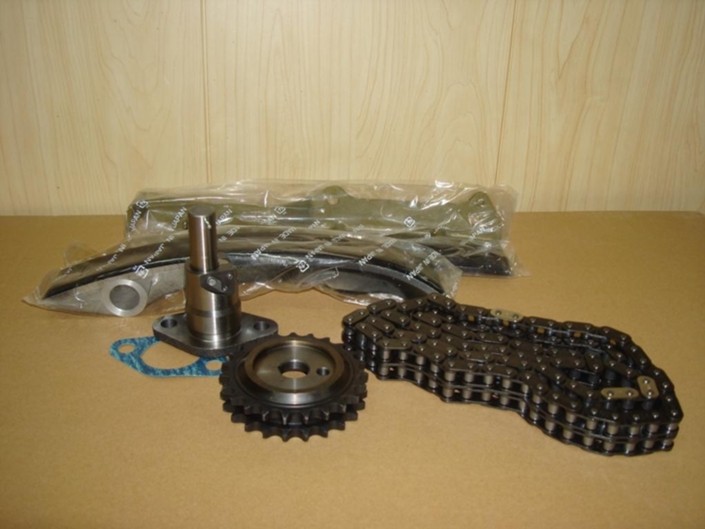
Mitsubishi 4m40 engine
Content

This is an in-line 4-cylinder diesel power unit with an overhead camshaft. 4m40 is equipped with a cast-iron cylinder block and a semi-aluminum cylinder head. The engine capacity is 2835 cmXNUMX.
Engine description
Any motor installation must be balanced by inertial forces. 4m40 is no exception. 2 additional balancer shafts are responsible for this function. They are driven by intermediate gears from the crankshaft, and are located as follows: top right and bottom left. The engine crankshaft is steel, based on 5 bearings. The piston of a special type, semi-aluminum, is connected to the connecting rod by means of a floating pin.
The rings are made of cast iron. Swirl combustion chambers (VCS) are installed in the cylinder head, making it possible to increase the fuel efficiency indicator. In fact, these are closed metal chambers installed in the cylinder head. Inside there is a ceramic-metal insert and a spherical screen forming an air gap with the inner surface of the chamber. In addition to ensuring complete combustion of the fuel, the VCS allows to reduce the amount of nitrogen oxides.
The camshaft of the 4m40 engine and high pressure fuel pump is driven from the crankshaft by means of a gear.

Technical specifications
| Winemaking | Kyoto engine plant |
| Engine make | 4M4 |
| Years of issue | 1993-2006 |
| Cylinder block material | cast iron |
| engine's type | diesel |
| Configuration | in-line |
| Number of cylinders | 4 |
| Valves per cylinder | 2 |
| The piston stroke, mm | 100 |
| Cylinder diameter, mm | 95 |
| Compression ratio | 21.0 |
| Engine displacement, cc | 2835 |
| Engine power, hp / rpm | 80/4000 |
| 125/4000 | |
| 140/4000 | |
| Torque, Nm / rpm | 198/2000 |
| 294/2000 | |
| 314/2000 | |
| Environmental standards | — |
| Turbocharger | MHI TF035HM-12T |
| Engine weight, kg | 260 |
| Fuel consumption, l/100 km (for Pajero 2) | |
| - town | 15 |
| - track | 10 |
| - funny. | 12 |
| Oil consumption, gr. / 1000 km | to 1000 |
| Engine oil | 5W-30 |
| 5W-40 | |
| 10W-30 | |
| 15W-40 | |
| How much oil is in the engine, l | 5,5 |
| Oil change is carried out, km | 15000 |
| (better than 7500) | |
| Engine operating temperature, deg. | 90 |
| Engine resource, thousand km | |
| - according to the plant | — |
| - on practice | 400+ |
| Tuning, h.p. | |
| - potential | — |
| - without loss of resource | — |
| The engine was installed | Mitsubishi L200, Delica, Pajero, Pajero Sport |
Operation and maintainability of a diesel engine
4m40 is better known as the Pajero 2 engine. It was first installed on this SUV in 1993. The diesel unit was introduced to replace the old 4d56, but the latter was still produced after that for some time.
The first thing that experts on diesel cars pay attention to is the turbine - its resource is 4m40 in the region of 300 thousand km. Once a year, be sure to clean the EGR valve. In general, the motor is reliable, with proper regular maintenance and refueling with good diesel fuel and oil, it will last at least 350 thousand km of the car’s run.
Problem areas of the 4m40 engine
| Problem | Description and Solution |
|---|---|
| Noisiness | There is high noise after stretching the timing chain. Therefore, it is important to check and change the drive in a timely manner. |
| Difficult start | Often this problem is solved by replacing the injection pump oil seal. In some cases, the check valve can be adjusted. |
| Cracks in the block head | One of the most common motor diseases. It is advisable to replace the cylinder head if gases have entered the expansion tank. |
| Disruption of the gas distribution system | The reason is not the timing belt, as on most engines. A strong chain is installed here, so adjusting the intake and exhaust valves will correct the malfunction of the GDS. |
| Power reduction, knocking | The problem is solved by cleaning and adjusting the valves. In the course of long-term operation, the gaps between the ends and cams increase, which affects the incomplete opening of the valves. |
| Unstable engine operation | It is recommended to check the hydraulic chain tensioner, which is very sensitive to oil pressure. |
| Increased fuel consumption, increased noise | Check injection pump. |
Valve adjustment on 4m40
After every 15 thousand kilometers on the engine, it is required to check / adjust the valves. The clearances on the "hot" internal combustion engine should be as follows:
- for intake valves - 0,25 mm;
- for graduation - 0,35 mm.
It is extremely important to adjust the valves on the 4m40, however, as on other motors. Diesel 4m40 is a rather complex mechanism, equipped with many different parts. In order for everything to work perfectly for a long time, it is necessary to carry out maintenance in a timely manner.

Valves are otherwise "plates" with long rods. Put them in the cylinder block. There are two valves per cylinder. When closed, they rest on saddles made of solid steel. So that the material of the "plates" is not damaged, the valves are made of special alloys that can withstand significant mechanical and thermal loads.
Valves are integral parts of the timing system. They are usually classified into inlet and outlet. The former are responsible for the intake of the fuel mixture, the latter for the exhaust gases.
In the process of long-term operation of the engine, the "plates" expand, and their rods lengthen. Therefore, the dimensions of the gaps between the pushing cams and the ends also change. If the deviations exceed the maximum permissible values, a mandatory adjustment will be required.
It is extremely important to make adjustments in a timely manner. For example, with small gaps, "burning" will inevitably occur - the operation of the gas distribution system will be disrupted, because an excessively thick layer of soot will accumulate on the mirrors of the "plates". With increased gaps, the valves will not be able to fully open. Because of this, engine power will be significantly reduced, the valves will begin to knock.
Timing chain drive: pros and cons
The 4m40 engine uses a double-row timing chain. It lasts much longer than the belt - approximately, about 250 thousand kilometers. This is a time-tested solution that has proven itself to be quite reliable. The chain drive is more durable, although it has a number of disadvantages.
- The increased noise level of the 4m40 engine is caused precisely by the use of a timing chain drive. However, this disadvantage is easily compensated by a well-conducted shvi of the engine compartment.
- After 250 thousand kilometers, the chain begins to stretch, a characteristic noise appears. True, this does not promise any serious problems - the part does not slip on the gears, the GDS phases do not go astray, the motor continues to work stably.
- Metal chain motors are comparatively heavier than belt driven motors. This negatively affects the tasks of modern production. As you know, in the race for competitors, everyone concentrated on more compact internal combustion engines, so they are trying to reduce the size of the power unit and its weight. The double row chain does not meet such standards in any way, except that the single row is narrow, but it is not for a powerful diesel 4m
- The chain drive uses a hydraulic tensioner, which is very sensitive to oil pressure. If it “jumps” for any reason, the chain teeth will begin to slip like on a conventional belt drive.

But the chain drive, along with the minuses, has many pluses.
- The chain is an internal part of the engine, and not output as a separate belt. This means that it is reliably protected from dirt, dust and water.
- Thanks to the use of a chain drive, it is possible to better set the phases of the GDS. The chain is not subject to stretching for a long time (250-300 thousand km), therefore, it does not care about the growing loads on the engine - the motor will not lose its initial power at increased and maximum speeds.
HPFP 4m40
The 4m40 engine initially used a mechanical injection pump. The pump worked with an MHI turbine and an intercooler. This was the 4m40 version, developing 125 hp. at 4000 rpm.
Already in May 1996, the designers introduced the use of a diesel engine with an EFI turbine. The new version developed 140 hp. at the same speed, the torque increased, and all this was achieved through the use of a new type of injection pump.
The high pressure pump is an essential element of a diesel engine. The device is complex, designed to supply fuel to the engine under strong pressure. In the event of a malfunction, mandatory professional repair or adjustment on special equipment is required.

In most cases, the 4m40 diesel injection pump fails due to low-quality fuel and oil. Dust, solid particles of dirt, water - if it is present in the fuel or lubricant, it enters the pump, and then contributes to the deterioration of expensive plunger pairs. The installation of the latter is carried out only by equipment with a micron tolerance.
It is easy to determine the malfunction of the injection pump:
- the nozzles responsible for spraying and injecting diesel fuel deteriorate;
- fuel consumption increases;
- increased exhaust smoke;
- the noise of the diesel engine increases;
- power decreases;
- difficult to start.
As you know, modern Pajero, Delica and Pajero Sport, equipped with 4m40, have an ECU - fuel injection is controlled by an electronic system. To determine the malfunction, you have to contact the diesel service, where there is professional testing equipment. In the course of diagnostic procedures, it is possible to identify the degree of wear, the residual life of spare parts of a diesel unit, the uniformity of fuel supply, pressure stability, and much more.
Mechanical injection pumps, which were installed on the first versions of the 4m40, were no longer able to provide the necessary dosing accuracy, as engineers increasingly changed the design, bringing it to new ECO standards. Emission standards were tightened everywhere, and the old type of high-pressure pump proved to be insufficiently productive.
For electronic systems, they came up with new fuel injection pumps of a distribution type, supplemented by controlled actuators. They made it possible to adjust the position of the dispenser and the automatic fuel injection advance valve.
4m40 has established itself as a powerful and reliable power unit. However, time does not stand still - the new 3m4 with a working volume of 41 liters was already installed on the Pajero 3,2. This engine is the result of many years of work by engineers who have identified and eliminated the weak points of the good, but outdated 4m40.

